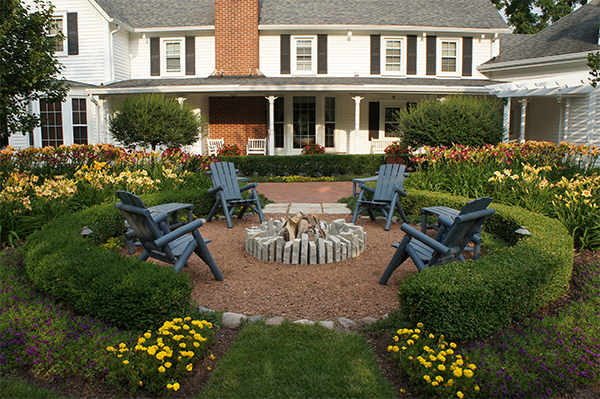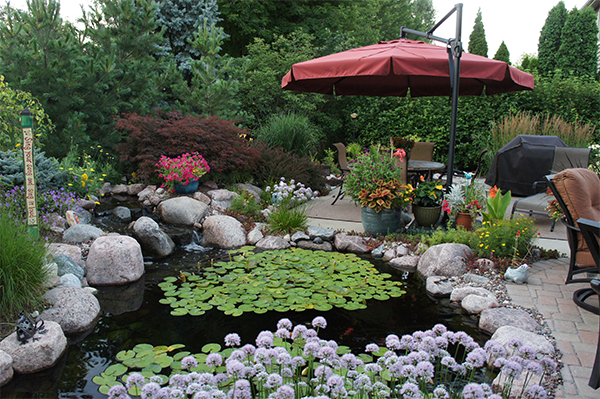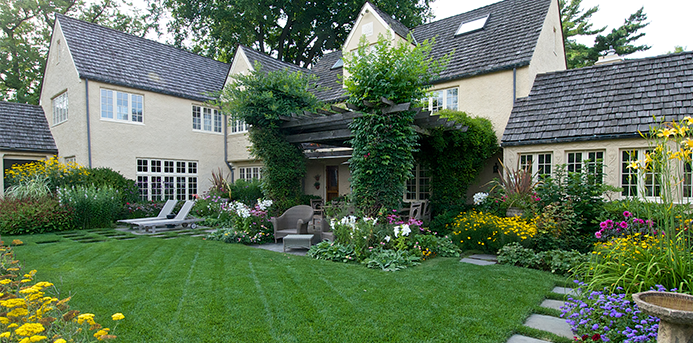Chicago winter has gone easy on us this year and it’s already starting to feel like spring. Now’s the time to start thinking about that landscape job you may have been putting off. Whether you’re going for a refresh of an existing landscape, a total tear-out of an eyesore left by a previous owner, or you don’t even know what you want or where to begin (only that you definitely need help!), we’ve got tips from three seasoned landscape and garden design professionals that are sure to ease the process.
Don’t Be Shy
Steve Kooyenga, senior landscape architect at Chalet Landscaping in Wilmette, encourages people to scout their neighborhoods for designs that catch their eye and follow up with the homeowner. Find out what that person’s experience was with the design company. Were they easy to work with? Considerate of their needs and ideas? Candid opinions are an invaluable tool for discovering the right person for the job.
“Referrals are a huge part of our business,” says Kooyenga. “I’ve designed for Chalet for 27 years and most of my clients are repeat or referral clients.”
If approaching strangers is a bit outside your comfort zone, ask friends for suggestions. Most importantly, don’t hesitate to ask a prospective designer for a portfolio. If you have a certain design aesthetic in mind, now’s the time to verify that the designer is capable of pulling it off.
“You want to make sure the designer has an appreciation for all design styles,” says Tony Butterworth, landscape designer for Christy Webber Landscapes. “You want to be able to have an open communication to help get your ideas across.”
That first phone call or face-to-face meeting can be pretty revealing. Does the designer show an interest in what you’re saying? Is he or she telling you what you want instead of asking? Did you come away feeling you were understood? Ensure that you confirm their experience and credentials too. How long have they designed? To what professional associations do they belong?

The Quote
Once you’ve settled on a designer and had several discussions about budget and vision, he or she will return to you in a specified amount of time to share a plan of attack. Tracy DiSabato-Aust, an internationally recognized garden designer, says when creating a plan, it is as important to consider the views looking out from inside your home as those from the outside. Hopefully your designer’s plan has taken those views into account, saving you from staring into your neighbor’s living room while washing dishes every evening.
Project costs are determined based on the amount of labor and materials needed to complete the work. Plant material, mulch, soil, brick, stone and debris removal will be included in the final cost. If a plan requires carpentry, irrigation, lighting or a water feature, a design/build company like Chalet will factor in the costs of those contractors to come up with a comprehensive quote.
As for negotiating final cost, it’s not a bad idea.
“Some companies will offer discounts based on the scope of the project,” says Kooyenga. “It never hurts to ask.”

How Involved Will You Be?
If you’re a hands-on gardener with a keen knowledge of plants and a desire to do some of the work yourself, it’s important to share that with the designer. Perhaps you’ll want the company to install the big stuff like trees, shrubs and hardscaping, while you’ll plant the annuals and perennials. Be sure that’s discussed before work begins since it could change the terms of the warranty the designer offers.
DiSabato-Aust says the majority of her clients rely on her to choose the best plants for the job but she welcomes the engaged client.
“There are some clients who are genuinely very interested and want to accompany me [to a garden center],” says DiSabato-Aust. “I’m ok with that and want them to be involved and committed. I like to have a lot of interaction with my clients.”
Good soil is the foundation of success. Without it, a design, no matter how beautiful, will fail. DiSabato-Aust encourages clients to ask the designer if the soil will be addressed before planting begins.
It’s a Wrap, Almost
This is where things can get tricky, particularly if you have little time or interest in caring for your landscape. Be honest with the designer so that he or she can create a quote for care and maintenance. Trees, especially, will need supplemental watering for at least the first few years.
DiSabato-Aust encourages homeowners to always request a care plan. Butterworth adds that while some clients are given a maintenance protocol, most defer to the design company for lawn care, pruning and fertilization schedules. The amount of labor required to keep that landscape looking its best will determine cost.
“Maintenance expectations need to be established before a plant is placed,” says DiSabato-Aust. “How much maintenance are you realistically able to do?”
More from Make It Better:

